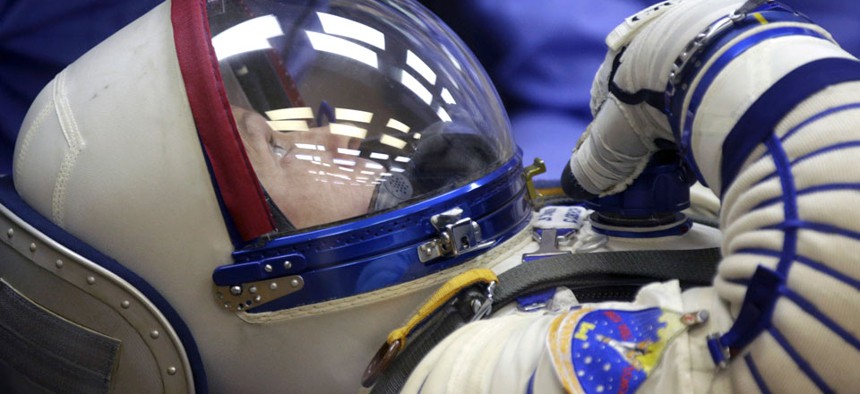NASA Weighs Ethics of Astronaut Health Risks on Long Missions Into Deep Space

U.S. astronaut Steven Swanson, a crew member of the mission to the International Space Station (ISS) tests a space suit during pre-launch preparations. Maxim Shipenkov/AP
Independent report offers ethical guidelines and a decision-making framework.
If humans are ever going to get to Mars and other deep-space destinations, we’ll need to figure out how people can live reasonably safely in space for very long durations, possibly indefinitely. In the meantime, we may have to send astronauts into situations we know are dangerous and expose them to unknown environments.
How will NASA decide when a mission’s potential gains outweigh the risks to human health? The agency asked the independent Institute of Medicine for recommendations, and that guidance came Wednesday in a report offering ethical principles and a framework for making such decisions.
Human space flight has always involved risks and pushed boundaries. Longer missions -- including lengthy stays on the International Space Station -- involve prolonged potential exposure to radiation, chemicals and microgravity as well as unknown elements, NASA Chief Health and Medical Officer Richard Williams told Nextgov. Such exposure can impair vision, reduce bone mass, cause certain types of cancer -- and that’s just some of what we currently know.
“You can get exposed at levels higher than your standards will allow, and there may be risks that you don’t fully understand and don’t have a standard for,” he said. The trick is determining the point beyond which further exposure is unacceptable. “We’ve always done that,” Williams said. “For long-duration missions it’s a matter of degree of exposure.”
NASA can’t ethically loosen it’s health standards in general or create a different set of health standards for long-duration flights, IOM determined. But in rare cases it might make sense to grant exceptions to the current standards, the report said.
In all stages of determining if exceptions to health standards are warranted, NASA should consider basic ethical principles. For instance, in reviewing requests for specific exceptions, IOM suggested the space agency could require the proposed missions --
- Be expected to have exceptionally great social value;
- Have great time urgency;
- Have expected benefits that would be widely shared;
- Be justified over alternate approaches to meeting the mission’s objectives;
- Establish that existing health and safety standards cannot be met;
- Be committed to minimizing harm and continuous learning;
- Have a rigorous consent process to ensure that astronauts are fully informed about risks and unknowns, meet standars of informed decision making, and are making a voluntary decision; and
- Provide health care and health monitoring for astronauts before, during and after flight and for the astronauts lifetime.
Surely, the astronauts themselves take on the greatest risk. “Some astronauts may be willing to accept more risks than others, but that has yet to be seen because we’re just getting to the point where we’re going to meet or exceed our standards,” Williams said. “Accepting some risk is mandatory -- it has to be done.”






